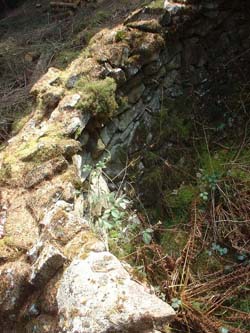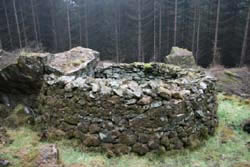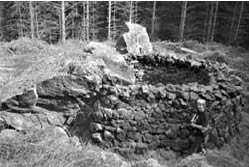
Detail showing the slight overhang of the roof
© R Grimshawe

Fox Trap Three

Detail showing the large boulder
incorporated into the wall

Note the height of the structure
© R Grimshawe.
Situated at 200 meters above sea level, this trap is the most elusive to find, being in the middle of thickly planted woodland. It does not appear on the 6ins to the mile Ordnance Survey map of the 1860s (I am reliably informed), and so one must deduce it is of recent origin.
The workmanship would support this view as it is constructed in a more regular form than the other two traps illustrated, which are made of large stones piled on each other, albeit with the evidence of a skilled stonemason to produce the curve of the roof. This trap was partially rebuilt in the 1970s.
The trap is approximately 65% intact, and larger than the other traps with an estimated internal diameter of 4.30m at the base. During the refurbishment the inside base was cleared and presumably reused. The north western side makes good use of a convenient boulder 2.5 m high by 2.5 m wide with a flat top.
There is anecdotal evidence from the area that this trap was baited with an 'old clucker', the fox gaining entry to the trap through a gap in the roof via the large boulder described above, and not the 'dead goose and plank ', etc. claimed to be used at other traps.
Behind the trap is an extensive boulder field with evidence of blocking, but not of recent origin.
 Website
manager
Website
manager